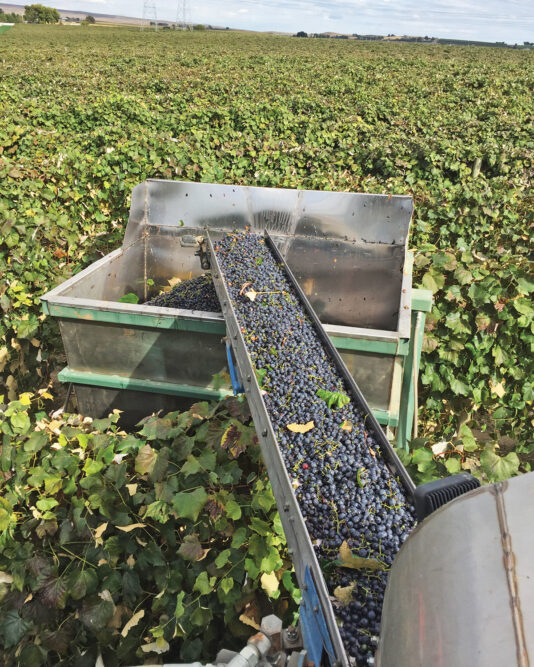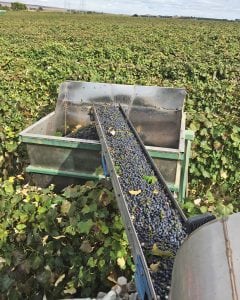
Home » Concord costs: The quest to keep juice grapes profitable
Concord costs: The quest to keep juice grapes profitable

May 6, 2018
Washington produces more juice grapes than any other state in the nation, fueling the building blocks for not just juice, but also jelly, fruit leather and syrup.
Despite sitting atop the U.S. supply, the state acreage of juice grapes has declined slightly in the past several years. People aren’t buying juice as often as they did, as more consumers worry about the sugar content of the naturally-grown product that’s also rich in vitamins C and K.
It’s put “global pressure on the juice grape industry,” said Trent Ball, Yakima Valley College agriculture department chairman.
In the mid-2000s, Washington had about 25,000 acres of land dedicated to juice grapes, compared to about 21,000 acres today, according to the U.S. Department of Agriculture. Concords are still the heavily dominant juice grape grown, with only about 1,000 acres of the overall total dedicated to Niagaras. Concord grapes are a dark bluish-purplish color, creating a dark purple or dark red juice. The Niagara variety is a green grape and may be used for white grape juice.
The cash price and overall value for juice grapes has dropped over time as well.
Washington has shifted focus to other commodities along the way, which once led to a growth in the production of hops and tree fruit. But not all crops can grow in the same spot where juice grapes once did. For example, Concord grapes are more tolerant of cold temperatures so can’t be replaced with wine grapes in every location.
The Yakima Valley still has a hold on the majority of the juice grapes grown in Washington, though a small amount also is produced in spots near the Snake River. The yearly crop can result in about 200,000 tons, though it’s a cyclical fruit with high-bearing years followed by low-bearing years. The 10-year average for state production is about 185,000 tons annually.
Dick Boushey has been growing juice grapes for Welch’s since 1980. He planted wine grapes at the same time as Concords, which allowed him to “watch both industries develop in different directions.”
Boushey described juice grapes as a “steady eddy” crop where returns are low, but don’t require a high cost per acre to grow. The biggest challenge tends to be keeping juice grapes profitable.
With wine grapes, “There’s a lot more detail and more particular pruning. I don’t make nearly as much on juice grapes,” Boushey said.

Sunnyside grower Ryan Schilperoort described being “late to the party” when he bought his first mechanical pruner a few years ago. He had been hand-pruning until then, but increases in minimum wage and labor shortages made it more cost effective to replace people with machines.
Minimizing labor costs also is a priority when it’s time to take fruit off the vine.
“You can handle the harvest with very few people,” Boushey said.
Mechanical harvesting is commonplace with juice grapes.
“Even though juice grapes and wine grapes look similar when growing, that’s really the end of the similarity,” said Vicky Sharlau, executive director of the Washington Winegrowers Association.
The fruit itself might look similar, but the vines are quite different. With wine grapes, the fruit tends to grow upward, with the fruit exposed to the sun. Juice grapes hang down and have a large canopy, hiding the fruit.
The reliability of growing juice grapes tends to make the product naturally organic without the official label. Boushey said he primarily uses water and fertilizer on his crops.
Schilperoort might use herbicides for weed control, but that’s about it, he said.
Concords often don’t need fungicides, pesticides or insecticides. To know when it’s time to pick, farmers test the fruit for its sugar content, usually looking for a value of 16 degrees Brix. The Brix scale measures the density of sugar in a solution.
Once harvested, juice grapes are sold either through a contract price or a cash price. The most recent values from 2016 were up $10 a ton from the prior year, to $120. But it’s still far from the surge in demand seen for the crop in 2012, which raised the cash price to $280 a ton. The biggest buyers of Washington juice grapes are Welch’s, Smucker’s, Milne Fruit, Tree Top, FruitSmart and Valley Processing.
Once grapes are crushed and stems removed, juice is processed to be sold in a 68 degrees Brix concentrate, which amounts to the grams of sugar for every 100 grams of liquid. The price per gallon for 68 Brix concentrate was $10 in 2017, but has been as high as $15 between 2004-12. Ball said a higher price for concentrate isn’t always immediately beneficial to farmers, as it can increase competition from alternative products.
In a typical season, Welch’s alone might process 100,000 to 120,000 tons of juice grapes, resulting in 20 to 22 million gallons of juice. The Grandview location stores all that juice, resulting in the largest juice tank farm in all of North America.
The juice market isn’t just being squeezed by consumers. Grape growers in both the wine and table grape industry have to work together to fight some of the regulations that come out of Olympia and Washington, D.C.
“When the FDA decided to do the Food Safety Modernization Act, they put in these produce safety rules, which make sense for items that are eaten raw,” Sharlau said. “When the FDA drafted these rules, they determined grapes were eaten raw. Well, table grapes are. And raisin grapes are. Juice grapes and wine grapes are not. They didn’t distinguish between the different crops of grapes, it’s just ‘grapes,’ which we are calling ridiculous. It’s one of those good intentions run amok.”
Challenges like this, combined with the profitability risk, may lead to more juice grape growers getting out of the business. Ball anticipates a drop in up to 400 acres statewide before the next season, and doesn’t see the likelihood of existing growers increasing their acreage.
“I’m set up to grow juice grapes and I know how to do it, so I’ve decided to stay with it and hope that it all works out,” Schilperoort said. Growers found a bright spot in the 2016 juice grape harvest, which benefited from a warm early season and no frost.
Eastern Washington land is still cheaper than in many parts of the country, but if the crop planted isn’t bringing a return, growers may have no choice but to shift to another commodity.
Still, Ball remains optimistic. He speaks yearly at the Washington Grape Society annual meeting, and his most recent update included a prediction that the price of juice grapes is likely to rise this year. Other markets in the U.S. and worldwide have been off in their production, leading to a drop in the supply and the chance for juice grapes to be more profitable for Washington state growers in 2018.
Agriculture + Viticulture
KEYWORDS focus agriculture viticulture 2018





